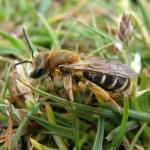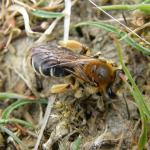Andrena similis Smith,1849, Andrena croceiventris Morawitz, 1871, Andrena rufo-hispida Dours, 1872, Andrena stefanii Pérez, 1895, Andrena ocreata cyprisina Warncke, 1975, Andrena (Taeniandrena) similis caraimica Osytshnjuk, 1994
This mining bee has been renamed from Andrena similis Smith,1849, it is a close relative of Andrena wilkella (Kirby), with which it could easily be confused. However, it differs from that species in having the postscutellum, and the lateral and posterior margins of the scutellum clad with very dense, short, erect, reddish-orange hairs. In addition the posterior hair-band of the third gastral tergite is very widely broken. In A. wilkella the surfaces of the scutellum and postscutellum are largely glabrous, and the posterior hair-band of the third tergite is only very narrowly broken medially.
The distribution extends from southern England north to Yorkshire and in Wales and again in northern Scotland. However, there are apparently no records from much of northern England and southern Scotland. Note the concentration of records in the vicinity of the Cromarty and Dornoch Firths. The species is not known from Ireland or the Channel Islands.
The species is widely distributed in the western Palaearctic, from southern Sweden and Finland south to northern Morocco, Algeria and Libya, east to Kazakhstan, the Middle East (Gusenleitner & Schwarz, 2002) and Afghanistan (Dylewska, 1987). The nominate form occurs throughout its European range, with the exception of southern Italy and Sicily, where it is replaced by A. similis croceiventris Morawitz.
Falk (1991) lists this species as Notable B (now known as Nationally Scarce Nb).
Throughout much of southern Britain this is a rare and very local bee but occurs in various habitats, including chalk grassland, moorland and rough coastal landslips. M Macdonald (pers. comm.) describes the bee as being quite common along forest rides in northern Scotland.
Univoltine; late April to the end of June.
Perkins (1919) reports the species as sometimes nesting in large, compact aggregations. Dylewska (1987) states that in mainland Europe the species nests singly.
Willow (sallow), aubretia, bilberry, pear, hawthorn, common bird’s-foot-trefoil, gorse, clover, sycamore, bogbean, ground-ivy and speedwell.
No Nomada has been associated with this mining bee. Specimens are very rarely stylopised, apparently by Stylops alfkeni (Perkins, 1919, 1943; Kinzelbach, 1971).
2012 - name changed 2024



